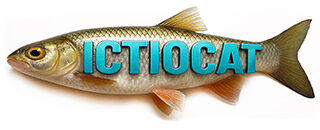Perca americana
Micropterus nigricans

La perca americana és un peix amb un cos robust que pot assolir una mida màxima a les nostres aigües d’uns 55 cm. Té una boca molt ampla on la mandíbula inferior sobresurt de la superior. Té dues aletes dorsals, la primera amb radis espinosos i la posterior amb radis tous. La coloració del cos és platejada amb tonalitats verdoses i unes bandes de taques irregulars fosques.
És una espècie originària de Nord-amèrica. A Catalunya va ser introduït fa més de mig segle i és present a la majoria d’embassaments i en alguns trams baixos de rius de corrent lent.
La perca americana prefereix les aigües lentes o sense corrent. A la primavera els mascles construeixen un niu on poden fresar múltiples femelles. S’alimenten d’invertebrats quan són joves i de peixos i crancs quan són adults.
En ser un gran depredador pot causar impactes sobre algunes espècies autòctones.
Distribució

Perca sol
Lepomis gibbosus

És un peix de mida petita que normalment no mesura més de 15 cm. El cos és alt i comprimit lateralment. En el marge posterior de l’opercle tenen una taca negre vorejada de vermell i blanc Tenen dues aletes dorsals fusionades, l’anterior amb radis espinosos. El cos és de colors vius i molt variats.
El peix sol és originari dels rius de la vessant atlàntica d’Estats Units. La introducció del peix sol a Catalunya és antiga i actualment es troba a la majoria de conques, tant als rius com als embassaments.
Habita als trams de riu de corrent lent, en zones de poca profunditat i amb vegetació. Els ous són defensats pels mascles fins que els alevins s’han dispersat. S’alimenten d’invertebrats i alevins de peixos.
El peix sol causa un gran impacte ecològic sobre les espècies autòctones a causa de la seva gran voracitat.
Distribució

